New Lower-Limb Gait Asymmetry Indices Based on a Depth Camera
Abstract
:1. Introduction
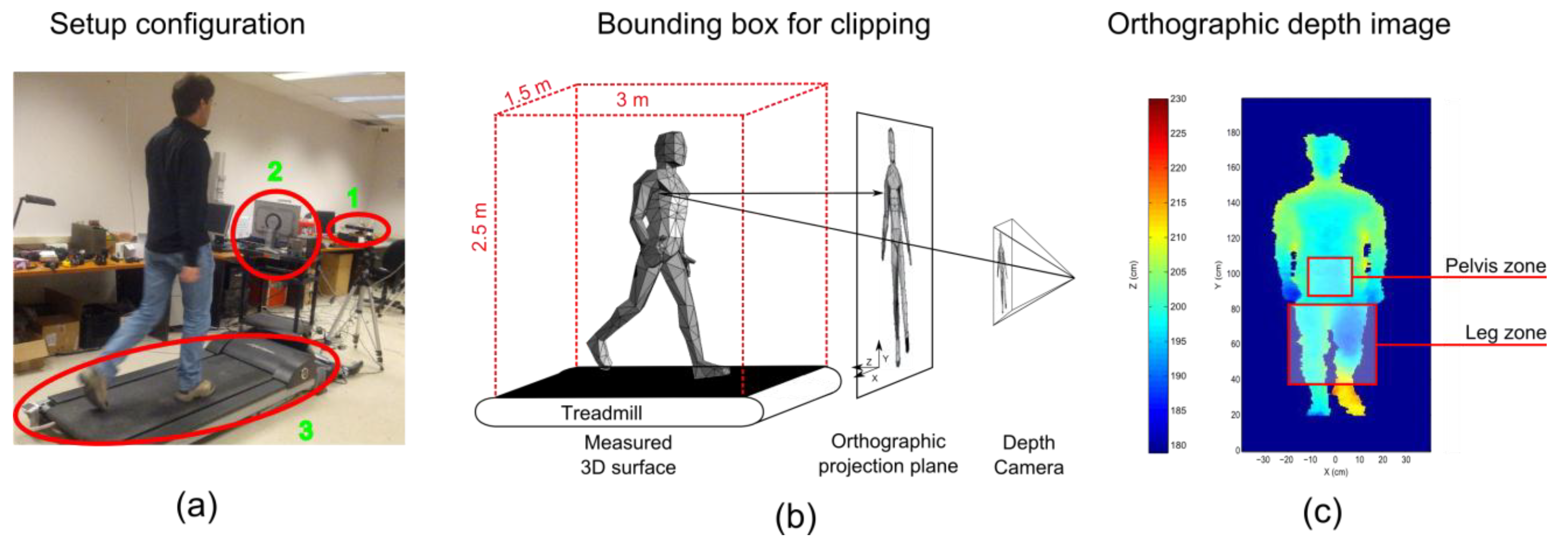
2. Method
2.1. Raw Depth Image Preprocessing
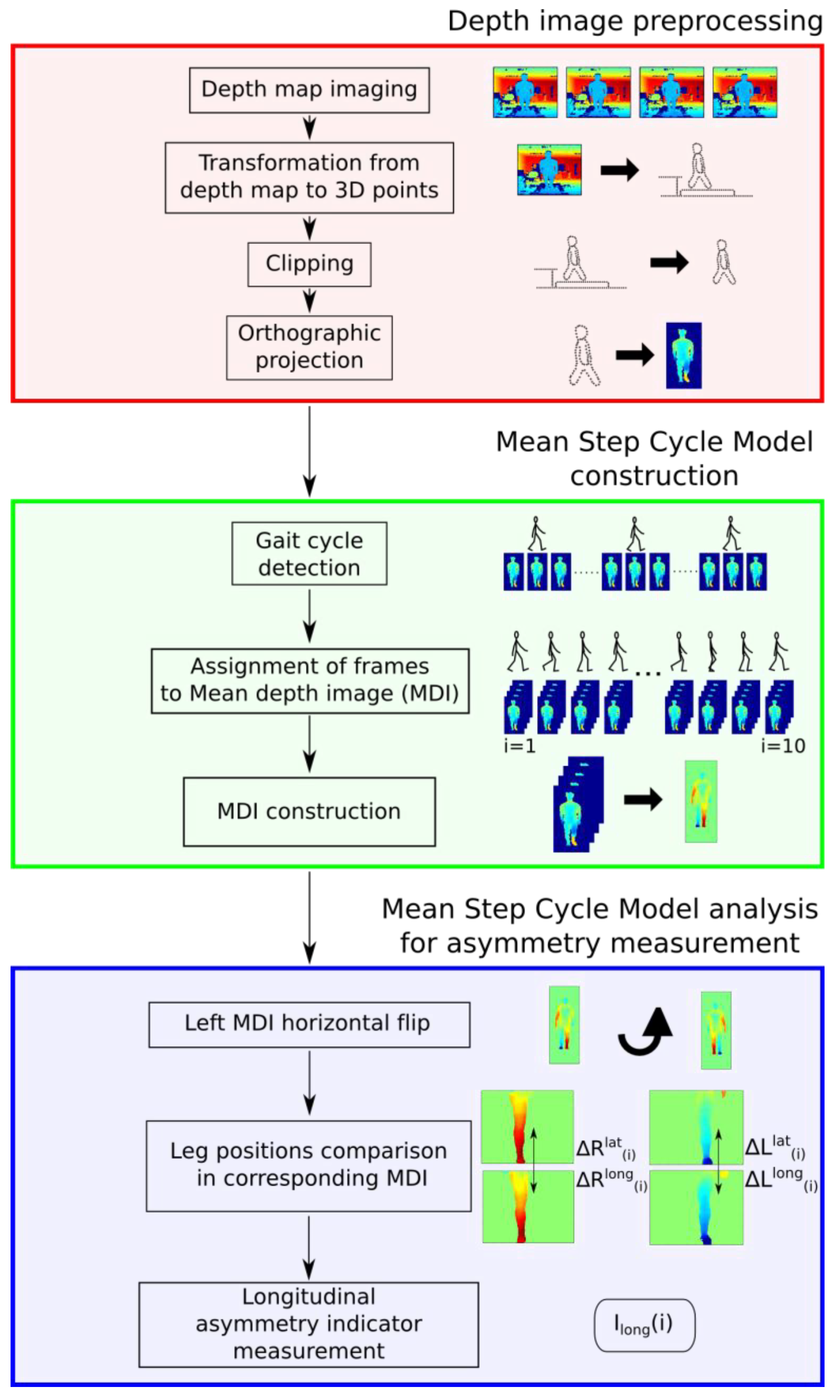
2.1.1. Transformation from Raw Depth Images to 3D Points
2.1.2. Clipping
2.1.3. Orthographic Projection
2.1.4. Lower-Limb Region of Interest and Pelvis Zone
2.2. Mean Step Cycle Model Computation
2.2.1. Step Cycle Detection
2.2.2. Assignation of Frame to Mean Depth Image
2.2.3. Mean Depth Image Construction
2.3. Asymmetry Index Based on the Mean Gait Cycle Model
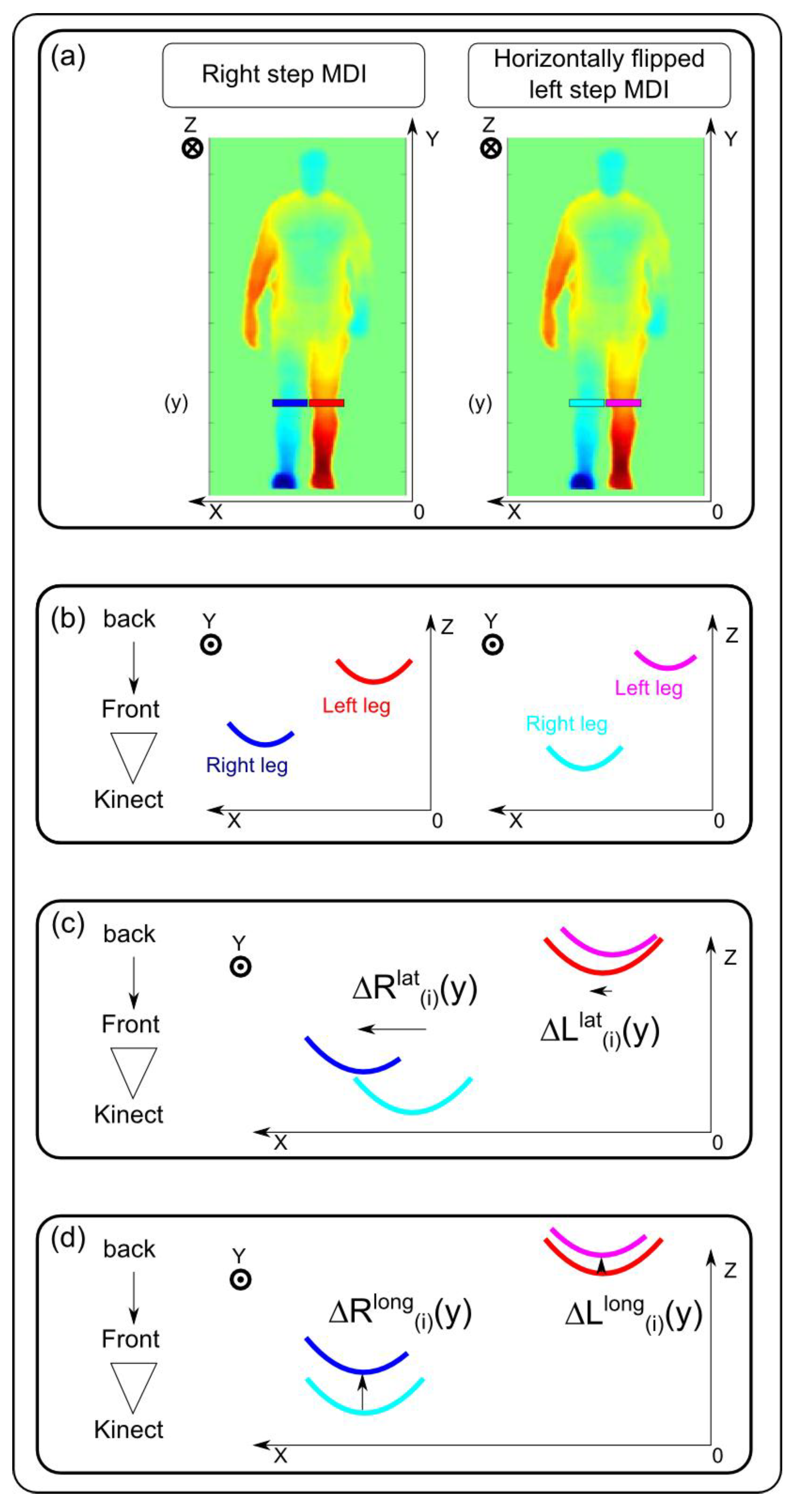
2.4. Asymmetry Index Based on Skeleton Information
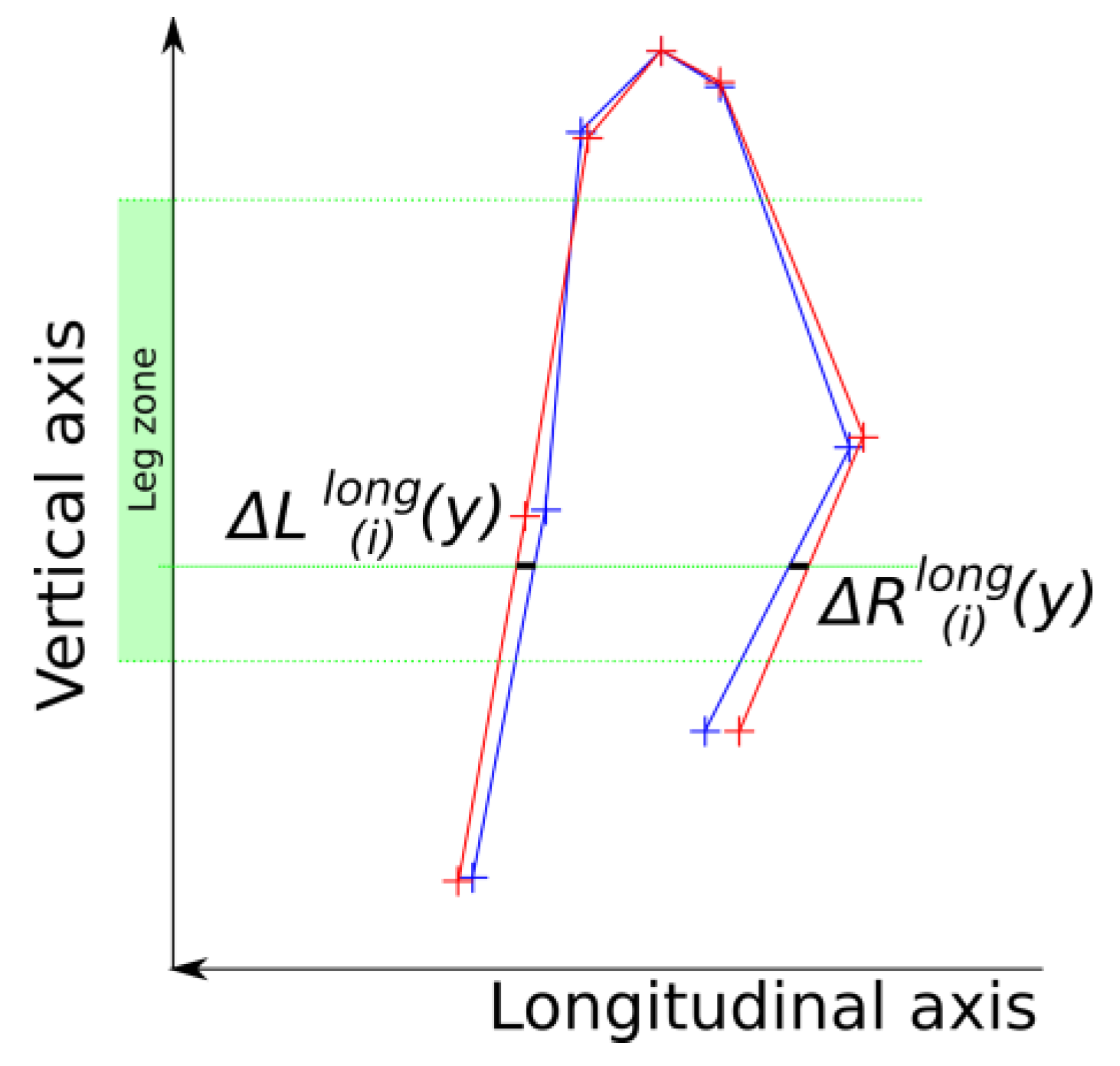
2.5. Experimentation
2.6. Statistical Analysis
3. Results
3.1. SRduration and SRlength
| Index | Left Deformed Gait | Normal Gait | Right Deformed Gait | ||
|---|---|---|---|---|---|
| Step length symmetry ratio (SRlength) with Kinect™ skeleton | |||||
| Left/right SR | 0.93 ± 0.11 | 1.01 ± 0.10 | 1.10 ± 0.18 | ||
| Statistical difference | p = 0.12 | p = 0.34 | |||
| Step duration symmetry ratio (SRduration) with Kinect™ skeleton | |||||
| Left/right SR | 0.99 ± 0.15 | 1.07 ± 0.18 | 1.18 ± 0.14 | ||
| Statistical difference | p = 0.17 | p = 0.49 | |||
| Step length symmetry ratio (SRlength) with motion capture skeleton | |||||
| Left/right SR | 0.87 ± 0.04 | 1.00 ± 0.04 | 1.15 ± 0.05 | ||
| Statistical difference | p < 0.001 * | p < 0.001 * | |||
| Step duration symmetry ratio (SRduration) with motion capture skeleton | |||||
| Left/right SR | 0.93 ± 0.04 | 1.00 ± 0.02 | 1.06 ± 0.04 | ||
| Statistical difference | p < 0.001 * | p < 0.001 * | |||
3.2. Asymmetry Index Based on a Skeleton Estimated with a Kinect™
| Index | Left Deformed Gait | Normal Gait | Right Deformed Gait | |||||
|---|---|---|---|---|---|---|---|---|
| Average longitudinal asymmetry index (Ilong) with the proposed method | ||||||||
| Asymmetry index | −50 ± 20 mm | 3 ± 15 mm | 53 ± 29 mm | |||||
| Statistical difference | p < 0.001 * | p < 0.001 * | ||||||
| Average longitudinal asymmetry index (Ilong) with motion capture data | ||||||||
| Asymmetry index | −57 ± 20 mm | 8 ± 17 mm | 56 ± 28 mm | |||||
| Statistical difference | p < 0.001 * | p < 0.001 * | ||||||
| Average longitudinal asymmetry index (Ilong) with Kinect™ skeleton data | ||||||||
| Asymmetry index | −38 ± 30 mm | −3 ± 25 mm | 48 ± 38 mm | |||||
| Statistical difference | p < 0.001 * | p < 0.001 * | ||||||
3.3 Asymmetry Index Computed with the Proposed Method Based on Raw Depth Images
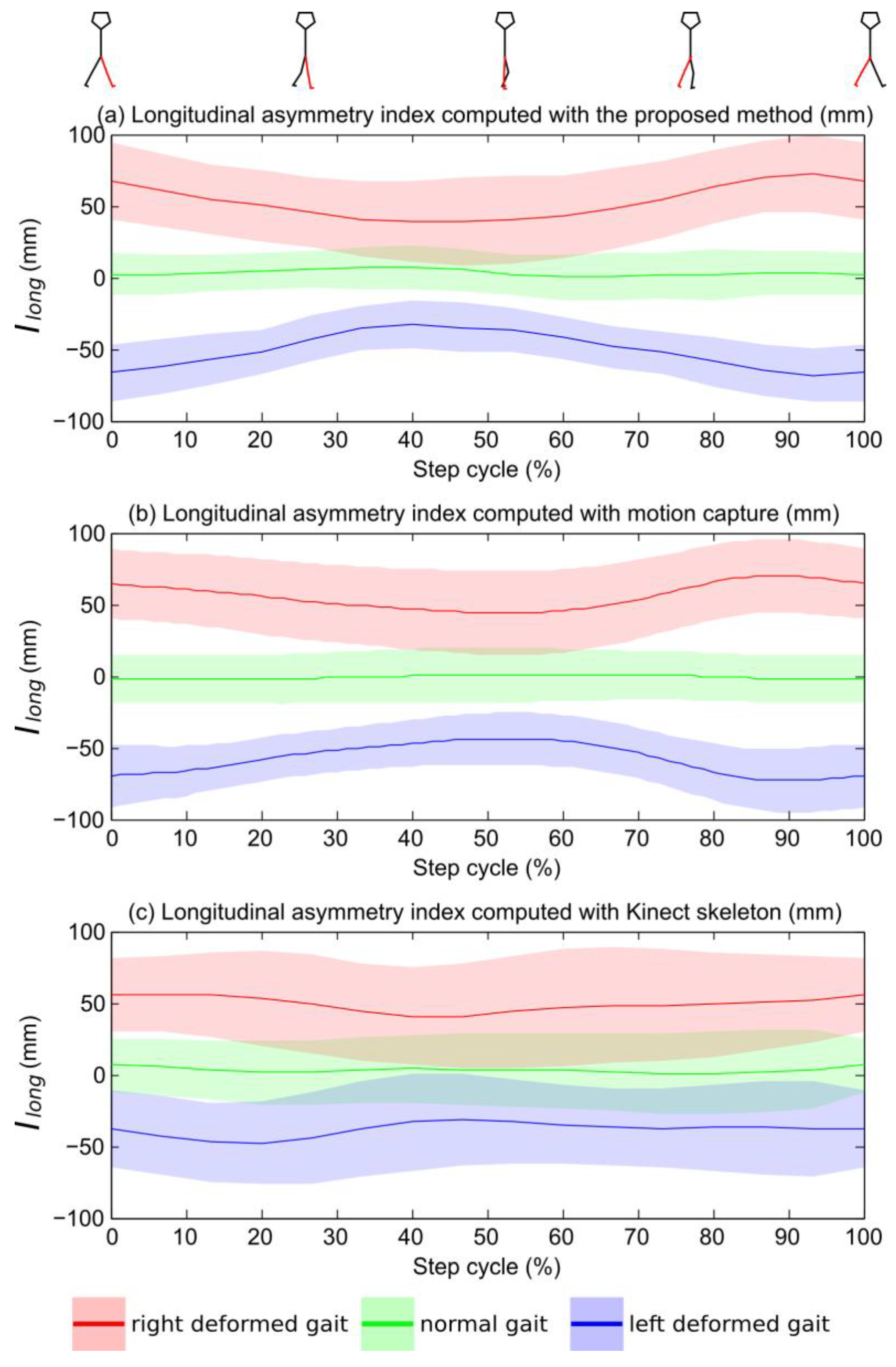
3.4. Sensibility of the Leg Zone Estimation

4. Discussion
5. Conclusions
Acknowledgment
Author Contributions
Abbreviation Table
| Abbreviation | Type | Name |
| DI | 2D image | Orthographic projection of the 3D surface of the subject |
| MDI | 2D image | Mean depth image |
| fMDI | 2D image | Horizontally-flipped mean depth image |
| MSCM | Group of MDI | Group of MDI |
| n | Numeric | Number of step cycles |
| i | Numeric | Interval of the step |
| Numeric | Longitudinal global displacement | |
| Numeric | Lateral global displacement | |
| c | Numeric | Step cycle number |
| s | {R,L} | Step side |
| Vector | Lateral asymmetry at the right leg | |
| Vector | Lateral asymmetry at the left leg | |
| Vector | Longitudinal asymmetry at the right leg | |
| Vector | Longitudinal asymmetry at the left leg | |
| Ilong(i) | Numeric | Longitudinal asymmetry index value at the instant i of the step |
| Ilong | Numeric | Mean value of the longitudinal asymmetry index for the step |
| SRlength | Numeric | Right step length versus left step length ratio |
| SRduration | Numeric | Right step duration versus left step duration ratio |
Conflicts of Interest
References
- Griffin, M.P.; Olney, S.J.; McBride, I.D. Role of symmetry in gait performance of stroke subjects with hemiplegia. Gait Posture 1995, 3, 132–142. [Google Scholar] [CrossRef]
- Sadeghi, H.; Allard, P.; Prince, F.; Labelle, H. Symmetry and limb dominance in able-bodied gait: A review. Gait Posture 2000, 12, 34–45. [Google Scholar] [CrossRef] [PubMed]
- Böhm, H.; Döderlein, L. Gait asymmetries in children with cerebral palsy: Do they deteriorate with running? Gait Posture 2012, 35, 322–327. [Google Scholar] [CrossRef] [PubMed]
- Patterson, K.K.; Gage, W.H.; Brooks, D.; Black, S.E.; McIlroy, W.E. Evaluation of gait symmetry after stroke: A comparison of current methods and recommendations for standardization. Gait Posture 2010, 31, 241–246. [Google Scholar] [CrossRef] [PubMed]
- James, P.; Nicol, A.; Hamblen, D. A comparison of gait symmetry and hip movements in the assessment of patients with monoarticular hip arthritis. Clin. Biomech. 1994, 9, 162–166. [Google Scholar] [CrossRef]
- Gurney, B. Leg length discrepancy. Gait Posture 2002, 15, 195–206. [Google Scholar] [CrossRef] [PubMed]
- Auvinet, B.; Berrut, G.; Touzard, C.; Moutel, L.; Collet, N.; Chaleil, D.; Barrey, E. Reference data for normal subjects obtained with an accelerometric device. Gait Posture 2002, 16, 124–134. [Google Scholar] [CrossRef] [PubMed]
- Gouwanda, D.; Senanayake, S.A. Identifying gait asymmetry using gyroscopes-A cross-correlation and Normalized Symmetry Index approach. J. Biomech. 2011, 44, 972–978. [Google Scholar] [CrossRef] [PubMed]
- Kaufman, K.R.; Miller, L.S.; Sutherland, D.H. Gait asymmetry in patients with limb-length inequality. J. Pediatr. Orthop. 1996, 16, 144–150. [Google Scholar] [CrossRef] [PubMed]
- Corazza, S.; Mündermann, L.; Chaudhari, A.M.; Demattio, T.; Cobelli, C.; Andriacchi, T.P. A markerless motion capture system to study musculoskeletal biomechanics: Visual hull and simulated annealing approach. Ann. Biomed. Eng. 2006, 34, 1019–1029. [Google Scholar] [CrossRef] [PubMed]
- Clark, R.A.; Bower, K.J.; Mentiplay, B.F.; Paterson, K.; Pua, Y.H. Concurrent validity of the Microsoft Kinect for assessment of spatiotemporal gait variables. J. Biomech. 2013, 46, 2722–2725. [Google Scholar] [CrossRef] [PubMed]
- Paolini, G.; Peruzzi, A.; Mirelman, A.; Cereatti, A.; Gaukrodger, S.; Hausdorff, J.M.; Della Croce, U. IEEE Transactions on Neural Systems and Rehabilitation Engineering. Available online: http://ieeexplore.ieee.org/stamp/stamp.jsp?arnumber=6998126 (accessed on 17 February 2015).
- Stone, E.E.; Skubic, M. Unobtrusive, continuous, in-home gait measurement using the Microsoft Kinect. IEEE Trans. Biomed. Eng. 2013, 60, 2925–2932. [Google Scholar] [CrossRef] [PubMed]
- Shotton, J.; Fitzgibbon, A.; Cook, M.; Sharp, T.; Finocchio, M.; Moore, R.; Kipman, A.; Blake, A. Real-time human pose recognition in parts from single depth images. In Proceeding of the 24th IEEE Conference on Computer Vision and Pattern Recognition (CVPR), Colorado Springs, CO, USA, 21–23 June 2011; pp. 1297–1304.
- Pfister, A.; West, A.M.; Bronner, S.; Noah, J.A. Comparative abilities of Microsoft Kinect and Vicon 3D motion capture for gait analysis. J. Med. Eng. Technol. 2014, 38, 274–280. [Google Scholar] [CrossRef] [PubMed]
- Shepard, D. A two-dimensional interpolation function for irregularly-spaced data. In Proceedings of the 1968 23rd ACM National Conference, New York, NY, USA, 27–29 August 1968; pp. 517–524.
- NASA. Anthropometric Source Book Volume 2: A Handbook of Anthropometric Data, NASA Reference Publication 1978. Available online: https://archive.org/download/nasa_techdoc_19790005540/19790005540.pdf (accessed on 17 February 2015).
- Khoshelham, K.; Elberink, S.O. Accuracy and Resolution of Kinect Depth Data for Indoor Mapping Applications. Sensors 2012, 12, 1437–1454. [Google Scholar] [CrossRef] [PubMed]
- Auvinet, E.; Multon, F.; Aubin, C.E.; Meunier, J.; Raison, M. Detection of gait cycles in treadmill walking using a Kinect. Gait Posture 2014. [Google Scholar] [CrossRef]
- Wu, G.; Siegler, S.; Allard, P.; Kirtley, C.; Leardini, A.; Rosenbaum, D.; Whittle, M.; D’Lima, D.; Cristofolini, L.; Witte, H.; et al. ISB recommendation on definitions of joint coordinate system of various joints for the reporting of human joint motion—Part I: Ankle, hip, and spine. J. Biomech. 2002, 35, 543–548. [Google Scholar] [CrossRef] [PubMed]
- Leardini, A.; Cappozzo, A.; Catani, F.; Toksvig-Larsen, S.; Petitto, A.; Sforza, V.; Cassanelli, G.; Giannini, S. Validation of a functional method for the estimation of hip joint center location. J. Biomech. 1999, 32, 99–103. [Google Scholar] [CrossRef] [PubMed]
- Holt, K.G.; Hamill, J.; Andres, R.O. Predicting the minimal energy costs of human walking. Med. Sci. Sports Exerc. 1991, 23, 491–498. [Google Scholar] [CrossRef] [PubMed]
- Bhave, A.; Paley, D.; Herzenberg, J.E. Improvement in gait parameters after lengthening for the treatment of limb-length discrepancy. J. Bone Joint Surg. Am. 1999, 81, 529–534. [Google Scholar] [PubMed]
- Riley, P.O.; Paolini, G.; Croce, U.D.; Paylo, K.W.; Kerrigan, D.C. A kinematic and kinetic comparison of overground and treadmill walking in healthy subjects. Gait Posture 2007, 26, 17–24. [Google Scholar] [CrossRef] [PubMed]
© 2015 by the authors; licensee MDPI, Basel, Switzerland. This article is an open access article distributed under the terms and conditions of the Creative Commons Attribution license (http://creativecommons.org/licenses/by/4.0/).
Share and Cite
Auvinet, E.; Multon, F.; Meunier, J. New Lower-Limb Gait Asymmetry Indices Based on a Depth Camera. Sensors 2015, 15, 4605-4623. https://doi.org/10.3390/s150304605
Auvinet E, Multon F, Meunier J. New Lower-Limb Gait Asymmetry Indices Based on a Depth Camera. Sensors. 2015; 15(3):4605-4623. https://doi.org/10.3390/s150304605
Chicago/Turabian StyleAuvinet, Edouard, Franck Multon, and Jean Meunier. 2015. "New Lower-Limb Gait Asymmetry Indices Based on a Depth Camera" Sensors 15, no. 3: 4605-4623. https://doi.org/10.3390/s150304605
APA StyleAuvinet, E., Multon, F., & Meunier, J. (2015). New Lower-Limb Gait Asymmetry Indices Based on a Depth Camera. Sensors, 15(3), 4605-4623. https://doi.org/10.3390/s150304605





